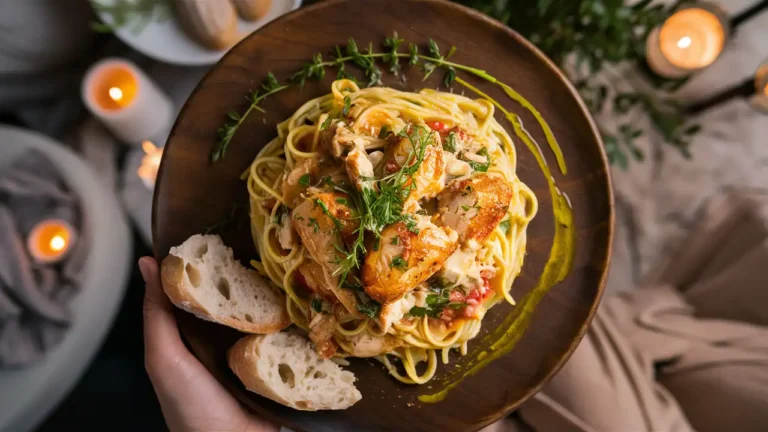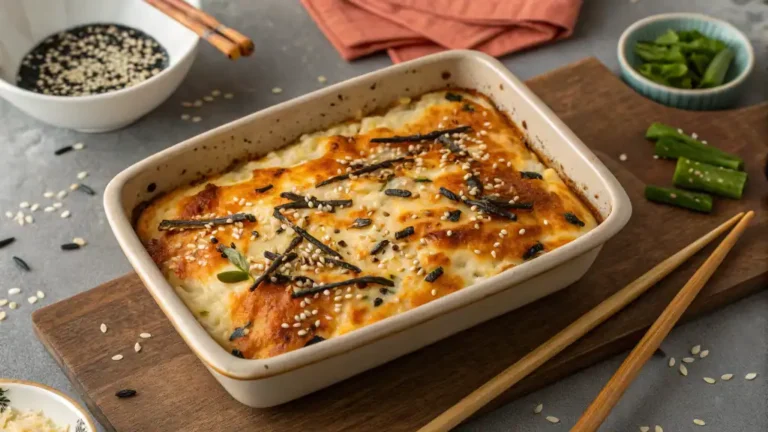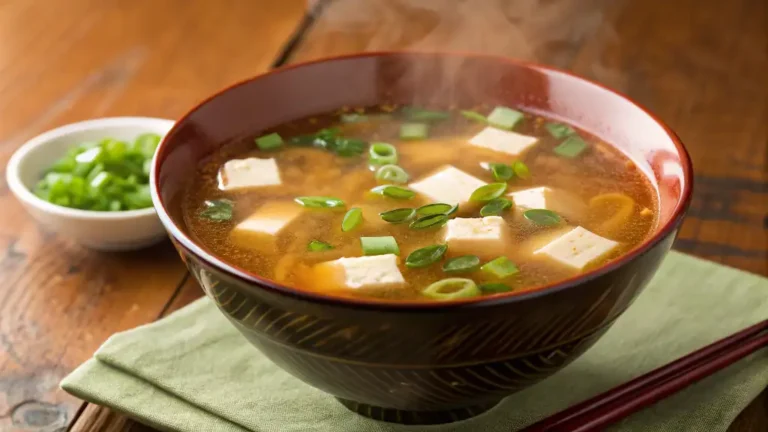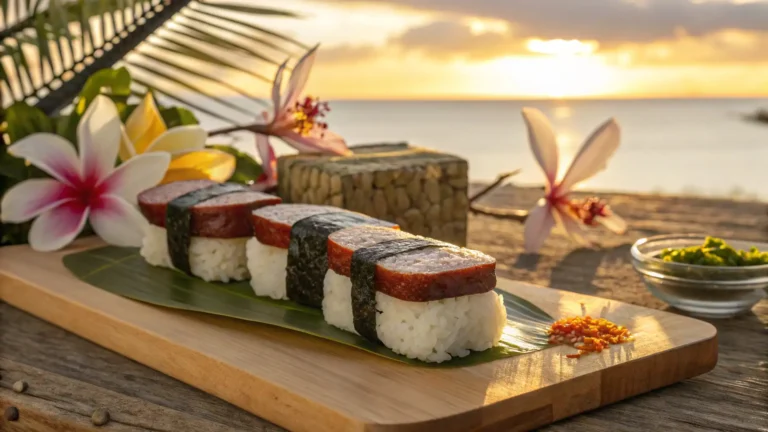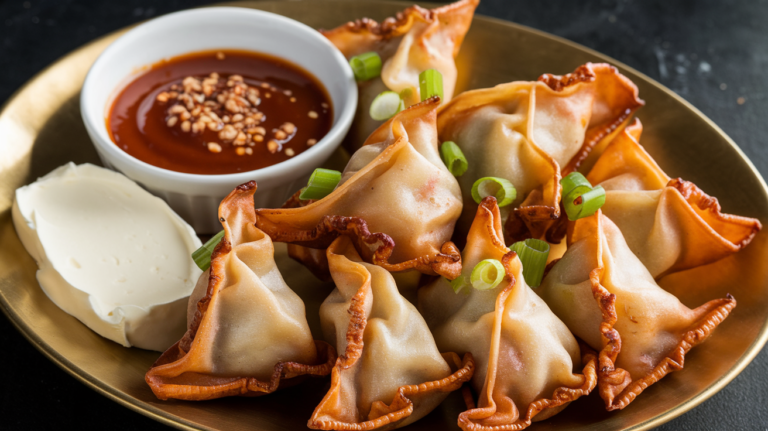Hot Pot Recipes: A Step-by-Step Guide for Delicious Results
Create a restaurant-quality hot pot at home! Learn how to choose the best soup base, meat, vegetables, and dipping sauce for a perfect feast.
JUMP TO RECIPE
What Is Hot Pot?
Hot pot is a fun and interactive way to enjoy a meal with friends and family. Making hot pot at home allows you to customize your broth, ingredients, and dipping sauces according to your taste. It transforms cooking into a communal dining experience where everyone can participate in creating their own perfect bowl.
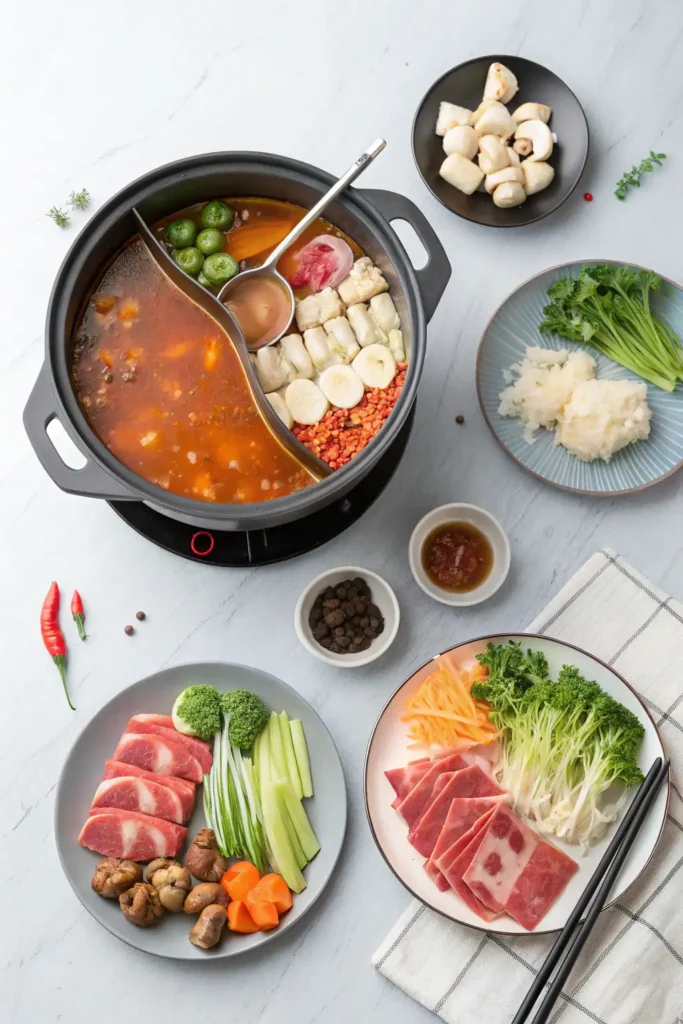
In this guide, I will share my tips and techniques for setting up a delicious hot pot right in your kitchen. From selecting the right equipment and preparing the soup base to choosing fresh ingredients, I’ll help you create a memorable meal that brings people together. Get ready to impress your guests with a warm and engaging dining experience.
Key Takeaways
- Customize your hot pot with your favorite broth and ingredients.
- Create delicious dipping sauces to enhance the flavors.
- Enjoy a fun communal dining experience with friends and family.
Hot Pot At Home
Hot pot is a fun and interactive dining experience. I enjoy making it at home because it allows for creativity with ingredients and flavors.
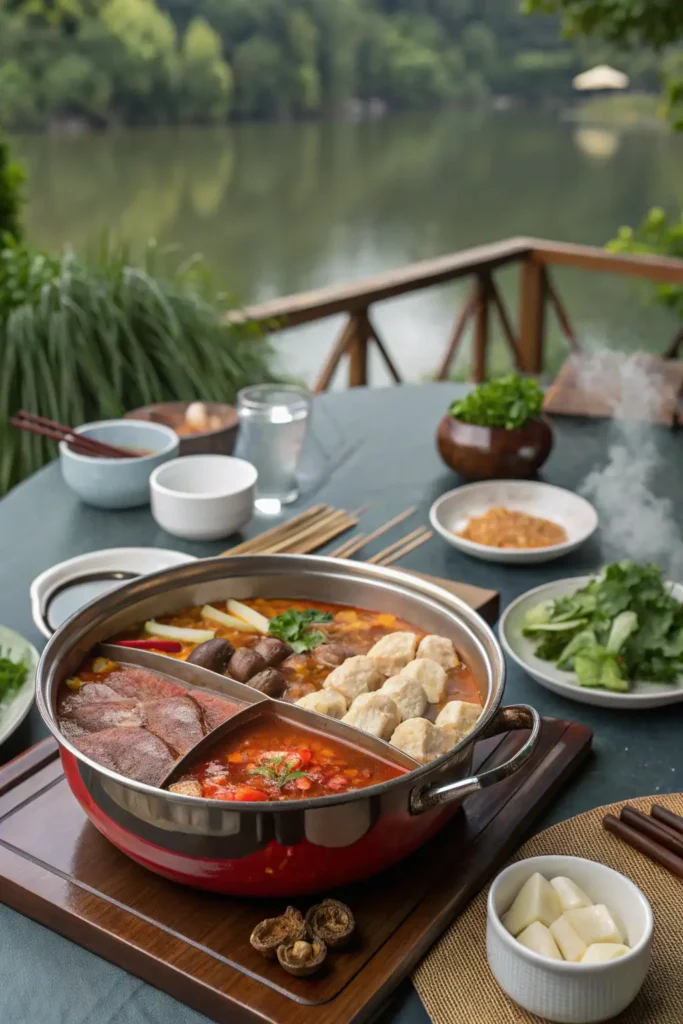
It originated in China and comes in several styles. Sichuan hot pot is known for its spicy broth, while shabu shabu features a lighter, more delicate flavor. I love the mix of tradition and personal preference in every meal.
A typical hot pot meal involves a simmering pot of broth. I often set up a variety of hot pot ingredients to create an inviting buffet. Common options include:
- Meats: Thinly sliced beef, pork, and chicken
- Seafood: Shrimp, fish fillets, and squid
- Vegetables: Leafy greens, mushrooms, and root vegetables
- Noodles: Rice noodles or egg noodles for a hearty touch
When I host a hot pot party, I arrange everything on a large table. Guests can choose ingredients and cook them in the broth. This creates a social environment where everyone enjoys the process.
Choosing the right broth is also crucial. I often pick a store-bought option or make a base at home for a personal touch.
With the right setup and ingredients, hot pot can be a delightful and customized meal that everyone can enjoy together. If you’re looking for the perfect appetizer to accompany your hot pot feast, try making Crab Rangoon Recipe—crispy, creamy, and the ideal starter for your meal!
What equipment do I need for hot pot?
Getting the right equipment is essential for a great hot pot experience. From pots to heating options, each piece plays a key role in the cooking process. Here’s what you need to know.
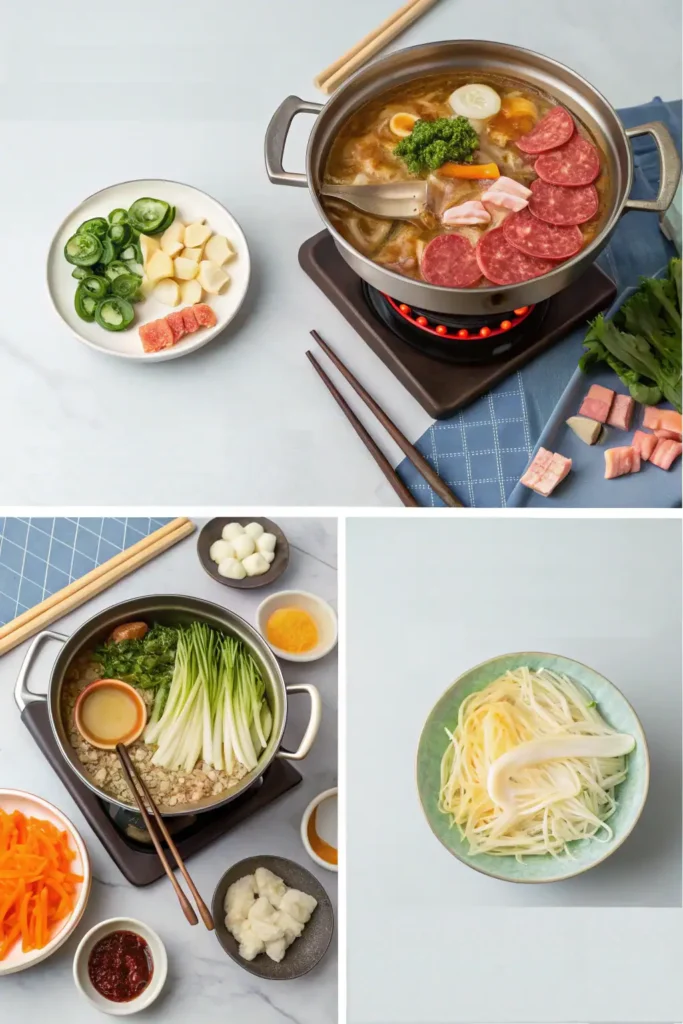
Choosing the Pot
I recommend using a pot that can handle high heat and has a good depth. A stainless steel pot is a solid choice because it warms quickly and lasts a long time. If you want a unique experience, a wok or a Dutch oven can work well, too. A split pot can be handy if you want to serve two broth flavors at once.
Consider the size of your group when choosing. A larger pot ensures everyone can enjoy the meal without waiting too long. If you’re using an induction cooktop, make sure your pot is compatible. A flat-bottomed pot works best for even cooking.
Heating Options
For cooking the broth, I have a few heating options in mind. If I want flexibility, a butane burner or camping stove is great for an outdoor setting. These are portable and easy to use.
For indoor cooking, an electric hot pot offers convenience and control. I appreciate models with adjustable temperature settings. If I prefer an induction stove, it is crucial to use compatible cookware. Always check the pot’s base for compatibility with induction heating. This choice can significantly impact how well your broth cooks.
Eating and Cooking Utensils
When it comes to utensils, I always make sure to have the right tools on hand. Tongs are essential for safely placing food into the hot broth and retrieving it once cooked. I prefer long tongs for reaching deeper into the pot.
Chopsticks also play a key role, allowing me to savor the flavorful ingredients directly. A strainer can help manage smaller food items like dumplings or vegetables.
Overall, having the right eating and cooking utensils enhances the experience. I suggest setting up a comfortable space with these tools nearby to keep the meal flowing smoothly. Enjoy this communal dish alongside our flavourful Marry Me Chicken Pasta Recipe for a hearty meal.
Hot Pot Soup Bases
To create a great hot pot experience at home, I focus on two main aspects: making the broth and choosing the right soup bases. Each step is key to a flavorful and enjoyable meal.
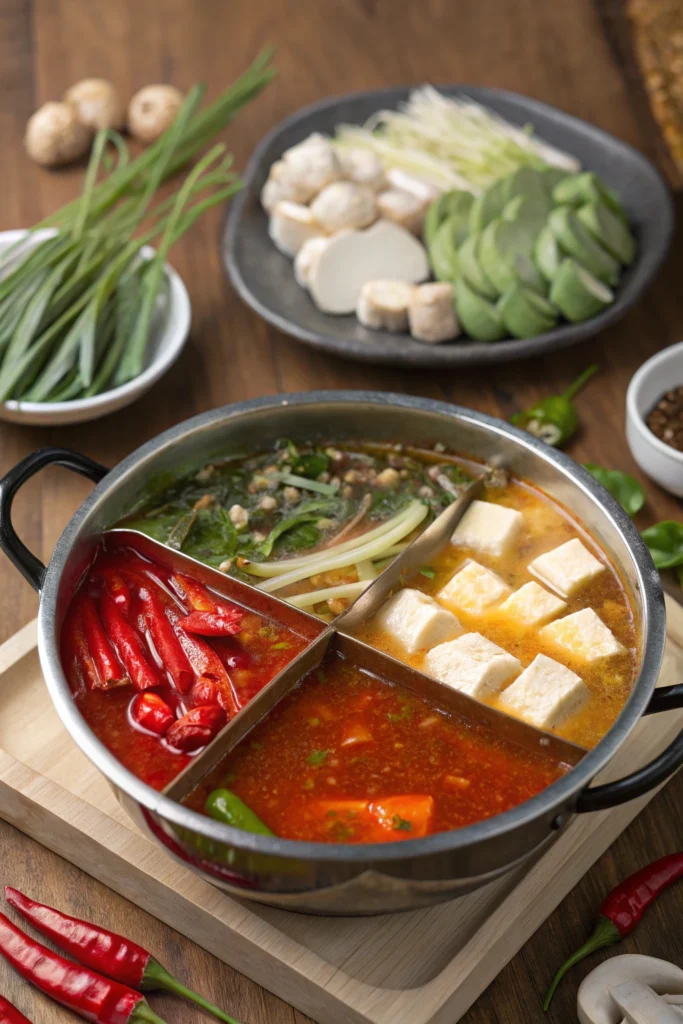
How do I choose the broth for my hot pot?
When I prepare my hot pot broth, I often start with a flavorful base. You can choose a traditional Chinese broth or opt for spicy Sichuan-style. I like to use ingredients like:
- Chicken or beef bones for depth
- Fresh ginger and garlic to add warmth
- Spices like star anise and cinnamon for aroma
I combine these in a large pot, cover with water, and simmer for at least an hour. This allows the flavors to blend. For a quicker option, I sometimes use premade broths or bouillon, like Lee Kum Kee Chicken Bouillon Powder. It’s important to taste and adjust seasoning as needed.
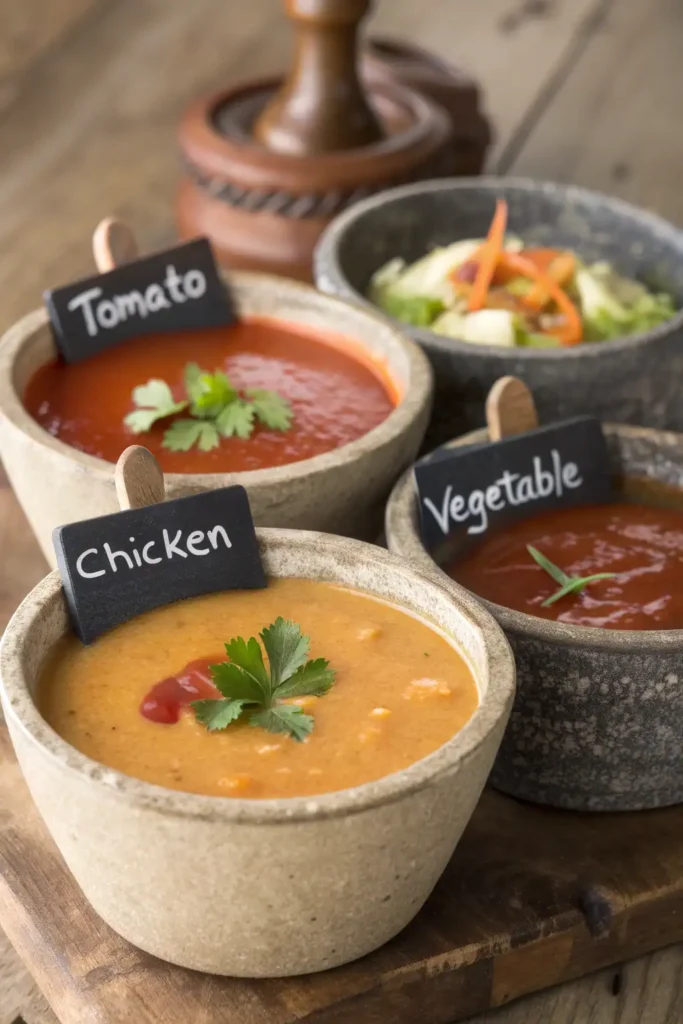
Choosing Soup Bases
Selecting the right soup base makes a big difference. I often explore options like Little Sheep hot pot soup base, which is popular for its balanced flavors. Here are a few types you might consider:
- Spicy Sichuan base: Great for those who enjoy heat.
- Vegetarian base: Perfect if I have vegetarian guests.
- Tomato or mushroom bases: These add a unique twist to the flavor.
When using a premade soup base, I read the instructions carefully. I add water to ensure I have enough liquid for cooking ingredients. With the right base chosen, I can create a rich and inviting broth ready for my favorite meats and vegetables.
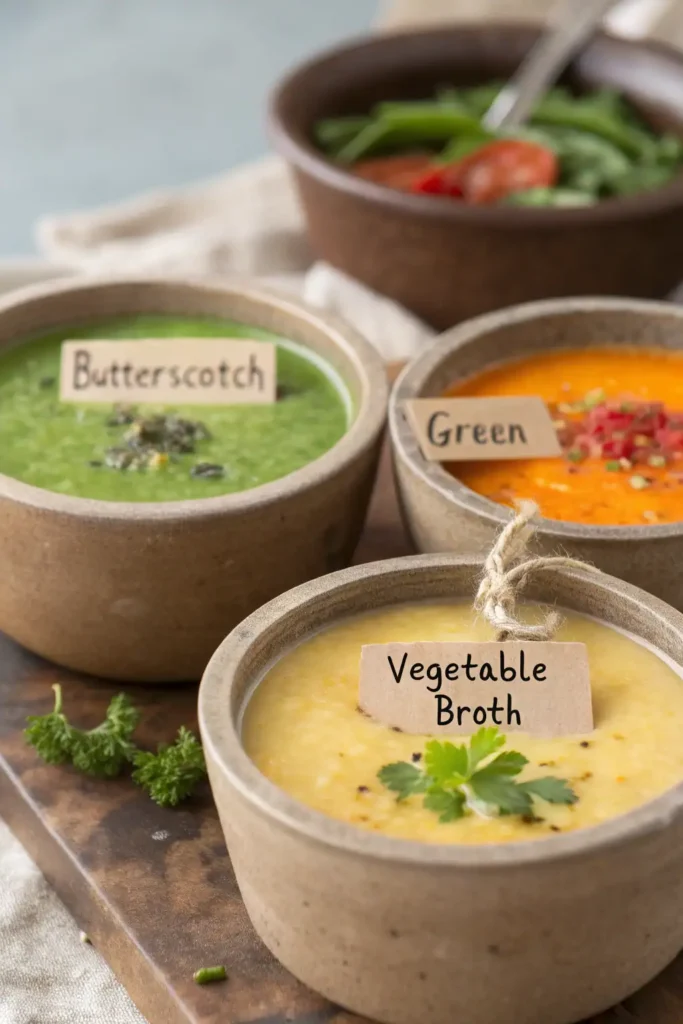
What ingredients should I prepare for hot pot?
When making hot pot at home, the ingredients you choose will greatly affect the flavor and enjoyment of the meal. I focus on a mix of meats, seafood, fresh vegetables, tofu, and noodles to create a delicious experience. Each category brings unique tastes and textures to the table.
Variety of Meats
Selecting the right meats is key to a successful hot pot. I like to use thinly sliced options for faster cooking. Here are my favorites:
- Beef: Flank or ribeye provides rich flavors.
- Pork: Pork belly or shoulder adds a nice fat content.
- Chicken: Chicken thighs can stay tender and juicy.
- Lamb: Lamb adds a distinct taste that pairs well with other ingredients.
I ensure each meat is sliced thinly for quick cooking. This keeps the meat tender and highlights its flavor in the broth.
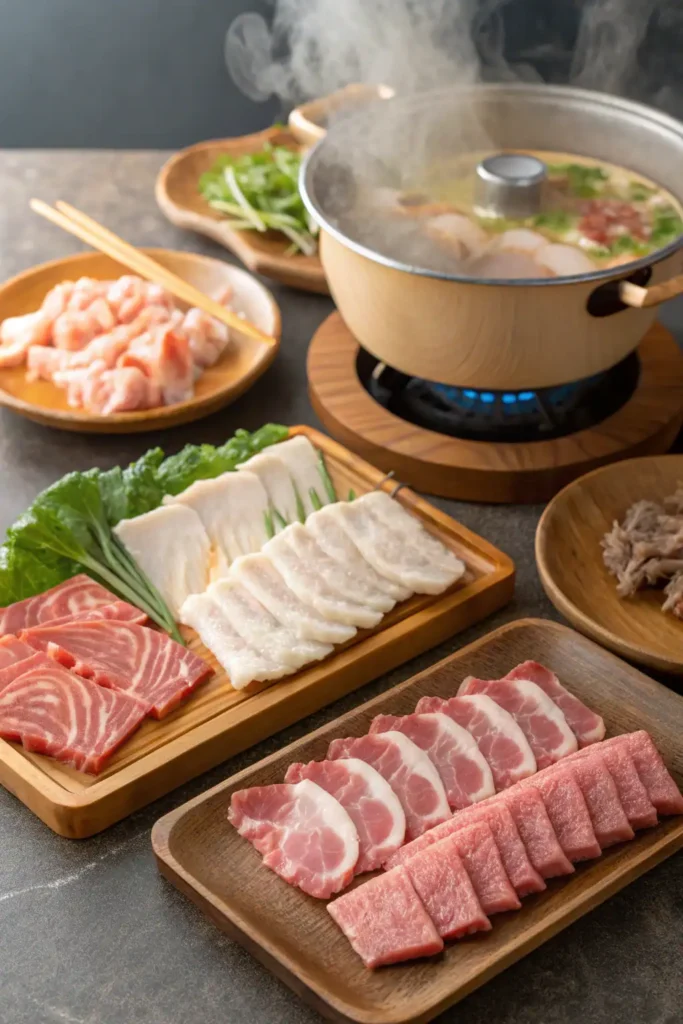
Seafood Selections
Seafood brings a fresh and delicate flavor to hot pot. I enjoy a variety of choices to enhance the dish:
- Shrimp: Peeled and deveined shrimp cooks quickly and absorbs broth flavors.
- Fish: Firm white fish like cod or tilapia works great.
- Fish Balls: These are tasty and add a fun texture.
- Crab or Scallops: These can elevate the meal, adding sweetness.
Using a mix of these seafood selections enriches the hot pot with different tastes.
Fresh Vegetables
I always include a range of fresh vegetables to balance the meal. Some of my favorites are:
- Napa Cabbage: This adds a mild sweetness and crunchy texture.
- Baby Bok Choy: Tender and full of flavor, it holds up well in the broth.
- Spinach: Adds a lovely color and cooks fast.
- Mushrooms: Varieties like shiitake or enoki introduce umami flavors.
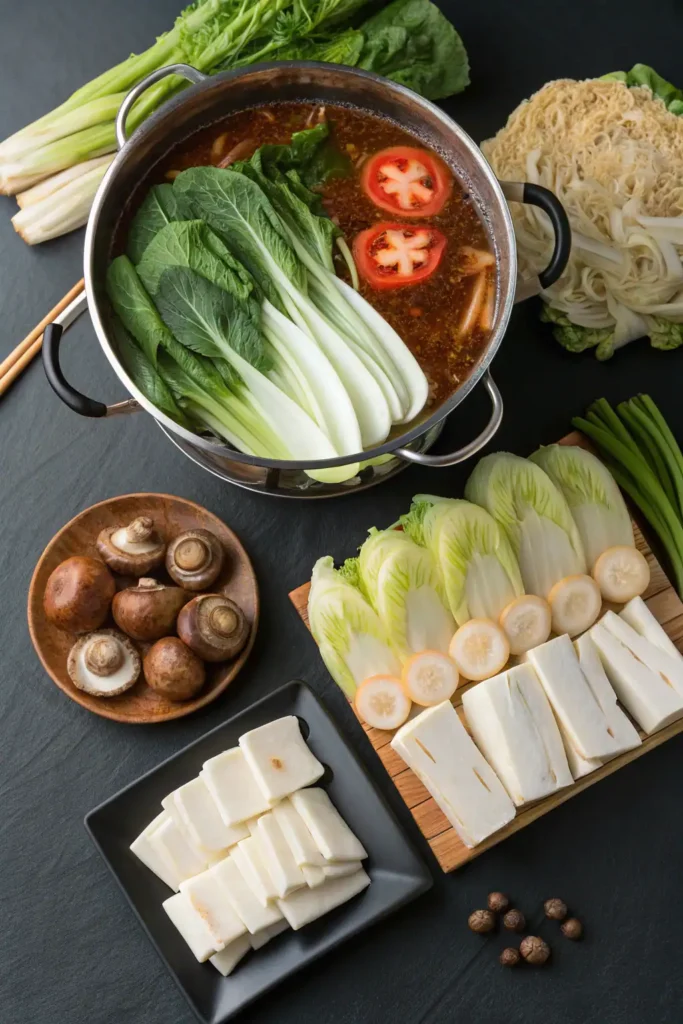
I cut these vegetables into bite-sized pieces for easy cooking and eating.
Tofu and Other Soy Products
Tofu is an essential ingredient in my hot pot, providing protein and texture. I recommend using:
- Firm Tofu: It holds its shape well during cooking.
- Fish Tofu: This has a unique taste and texture that complements other ingredients.
- Silken Tofu: It pairs nicely in the broth, adding creaminess.
Including these options creates a nice mix of textures and flavors, making every bite enjoyable.
Noodles and Starches
For the final touch, I add noodles and starches to soak up the broth. Here are my preferred choices:
- Bean Vermicelli: These noodles are light and cook quickly.
- Rice Noodles: They provide a soft texture and can absorb flavors.
- Potatoes: Thinly sliced, they add heartiness to the meal.
- Choy Sum: This green vegetable has a mild flavor and pairs well with starches.
Adding these noodles and starches completes the hot pot, making it filling and satisfying. Looking for more unique dishes? Try Salmon Sushi Bake—it’s a creamy, savory delight perfect for potlucks or sides.
What are some popular dipping sauces for hot pot?
Creating the right dipping sauces is essential for a delicious hot pot experience. These sauces can enhance flavors and add excitement to your meal. Here’s how I prepare both basic sauces and customize flavors.
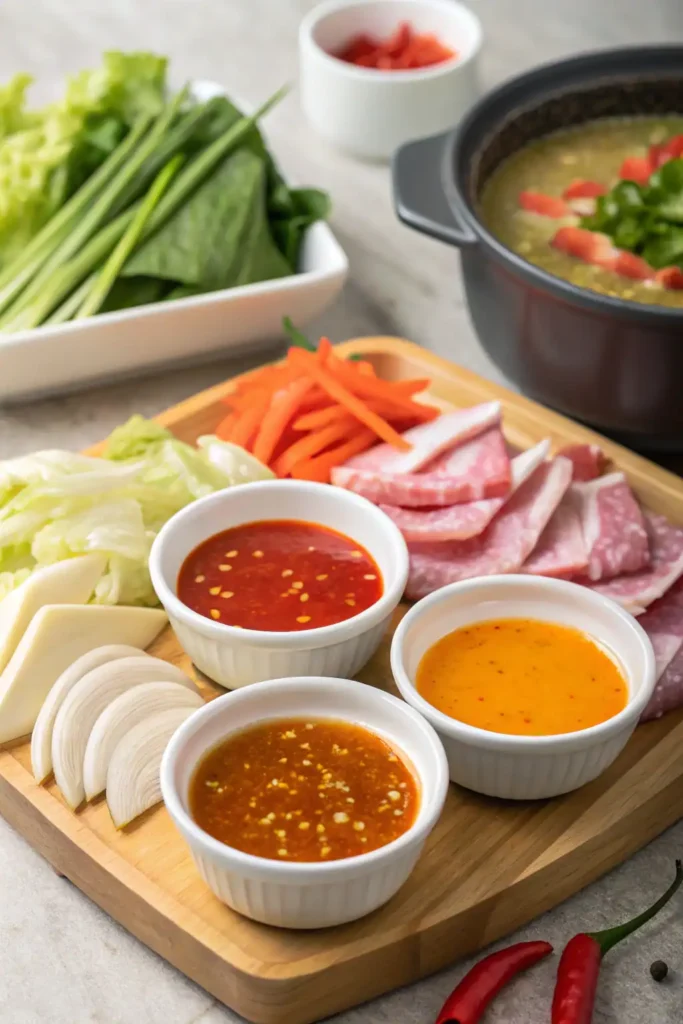
Basic Sauce Recipes
I often start with easy-to-make basic sauces that everyone can enjoy. Here are a few popular options:
- Soy Sauce Mix: Combine soy sauce, minced garlic, and chopped green onions. This mix is savory and refreshing.
- Sesame Sauce: Mix sesame paste with water, a splash of soy sauce, and sesame oil. This sauce is rich and nutty, perfect for adding depth.
- Sha Cha Sauce: Use minced garlic, shallots, and slightly spicy chili flakes. This sauce has a strong flavor that complements meats wonderfully.
These sauces can be adjusted in quantity based on your needs. I usually prepare small bowls for each person, allowing everyone to customize their dipping experience.
Customizing Flavors
To make my hot pot dipping sauces unique, I like to customize them with different ingredients. Here are some ideas:
- Fresh Aromatics: I often add diced ginger or cilantro for an extra burst of flavor.
- Heat Kick: If I want a spicy sauce, I mix in chili oil or sriracha. This increases the heat level for those who enjoy it.
- Sweet Notes: Adding a touch of sugar or honey can balance out stronger flavors. It’s a great way to create a more rounded taste.
Experimenting with different combinations lets me tailor sauces to my liking. I enjoy inviting friends over and letting them create their own perfect blend!
How To Host A Hot Pot Party
Hosting a hot pot party can be a fun and relaxing experience. Here are some tips to make it enjoyable.
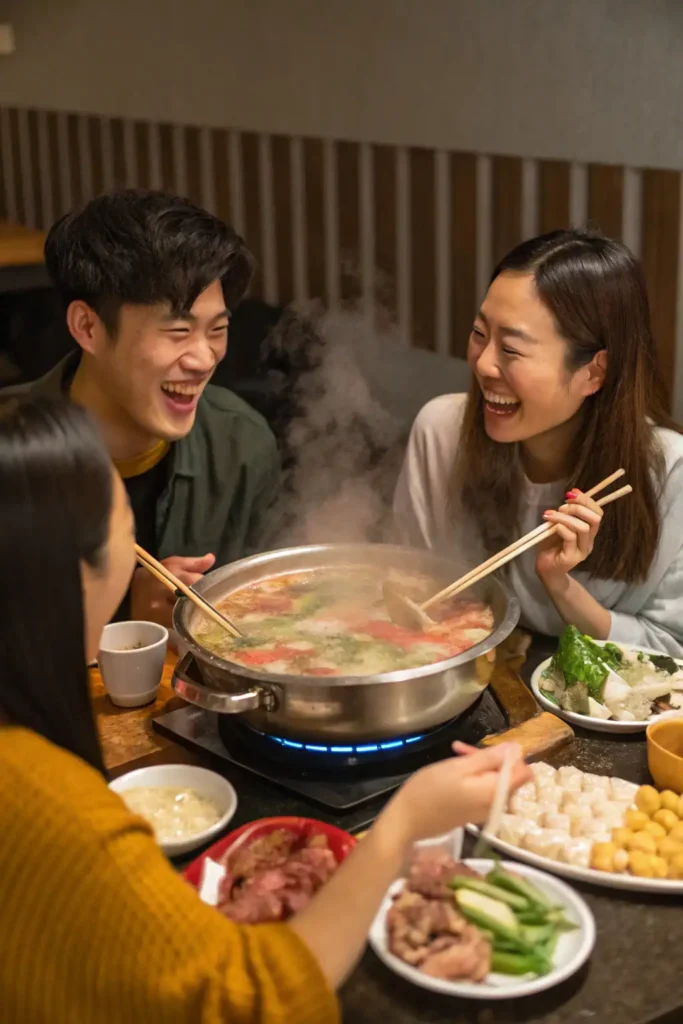
1. Gather the Right Equipment
I recommend using butane burners or a portable electric stove. This keeps the broth bubbling while guests cook their ingredients at the table.
2. Plan Your Ingredients
Choose a variety of proteins, vegetables, and noodles. Here’s a simple list:
- Proteins: Thinly sliced beef, shrimp, and tofu
- Vegetables: Bok choy, mushrooms, and spinach
- Noodles: Rice noodles or udon
3. Prepare Before Guests Arrive
Prep time can take 30 minutes to 2 hours. I like to chop vegetables and marinate proteins ahead of time. It’s helpful to ask friends to come over early to assist.
4. Set Up a Tasty Broth
A flavorful broth is key. I suggest using a mild base and offering spicy options for those who like heat.
5. Create a Comfortable Atmosphere
Warm up your space, especially in winter. Cozy settings encourage everyone to relax and enjoy.
6. Make Dipping Sauces
Offer a selection of sauces for dipping. I usually prepare soy sauce, sesame oil, and chili paste.
These simple tips can help create a memorable hot pot experience for everyone. Want a sweet treat to end your hot pot meal? Try Tanghulu Recipe—a crunchy, caramelized fruit snack that’s popular in Chinese street food culture!
What are some common mistakes to avoid when making hot pot at home?
When making hot pot at home, safety is important. Here are key points to keep in mind:
- Ingredient Freshness: Always purchase ingredients from reputable stores. Check for freshness, especially meats and seafood.
- Clean Preparation: Wash your hands and surfaces before starting. Use separate cutting boards for vegetables and raw meat to avoid cross-contamination.
- Cooking Equipment: I prefer using an induction cooktop for its safety features. If using a butane burner or portable stove, ensure it’s in a well-ventilated area to avoid gas buildup.
- Temperature Control: Keep the cooking broth at a consistent temperature. This helps cook ingredients thoroughly, reducing the risk of foodborne illness.
- Avoid Re-using Broth: Do not reuse broth that has cooked raw meat. It can harbor bacteria. Always start with fresh broth for each meal.
- Safe Serving: Use separate utensils for raw and cooked food. This prevents any bacteria from transferring back to the cooked items.
By following these safety tips, I can enjoy a delicious and safe hot pot experience at home. For a fusion twist, serve Spam Musubi alongside your hot pot. It’s a savory and satisfying addition to your table.
Save This Recipe For Hot Pot At Home!
Hot Pot At Home
Course: Main, Beef, Veggie, Meat, NoodlesCuisine: Chinese4
servings20
minutes30
minutes50
minutesMaking hot pot at home is fun and rewarding. Here’s how I keep everything organized.
Equipment
Metal pot or electric hot pot
Stove or portable burner
Chopsticks or small cooking tools
- Ingredients
- Broth
4 cups chicken or vegetable stock
Ginger, sliced
Garlic, minced
- Proteins
Thinly sliced beef or pork
Tofu, cubed
- Vegetables
Bok choy
Mushrooms
Carrots, sliced
Noodles
Rice noodles or udon
Directions
- Start by preparing your broth. Heat stock in a pot, adding ginger and garlic for flavor.
- While the broth simmers, chop vegetables and slice proteins. Arrange them on platters.
- Place the pot on the stove. Bring the broth to a boil, then reduce to a simmer.
- Use chopsticks to cook ingredients in the broth, enjoying them as they finish cooking.
Notes
- By following this recipe, You can enjoy a delightful hot pot experience at home, anytime!



